Breath and think simple from time to time... I'm a goofy artist and rookie animator, among other things!! Daydreaming a lot...
Don't wanna be here? Send us removal request.
Text
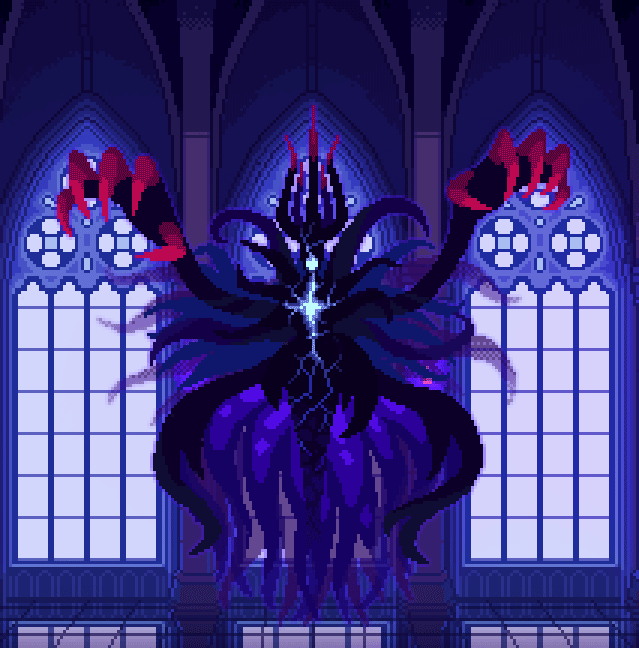
Update on The Dark Queen of Mortholme!
Phase one is now essentially completed for art, code and dialogue. Onwards to phase two; because every good boss fight needs that part where the boss gets unhinged and gains a whole new set of attacks.
I too have chosen to be unhinged and made a design for the Queen's final form that gobbles up animation work hours like nothing I've done before with pixel art.
Concept sketches under the cut:
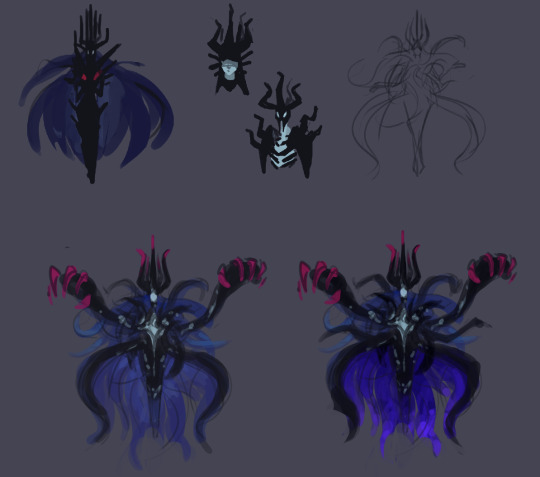
Initially I didn't have any ideas beyond doing a more monstrous design that amps up the Queen's features and takes cues from the shapes and colours of her original spell animations. However after writing the dialogue leading up to the transformation I immediately landed on a specific concept.
The transformation is an outburst. It's a manifestation of the Queen's terror and defiance towards her approaching death. She's unraveling, and in doing so she's channeling more of her innate violent power that she doesn't usually let out. She's essentially been having a long argument with the Hero about who they believe they are. Thus far she's gotten by being all smug and detached, but now she's losing and forced to reveal more of her true self to continue.
So her final form's design should convey 1. an outburst, and 2. the unraveling of a false front. Her base design's spikes, hair and skirt all erupt out into the wilder shape language of her shadowy spell-tendrils. They can handily be used to draw the eye from all directions towards the center of her chest, where I wanted to have this cracking pattern, like something hidden inside her is coming out. It's bright as if blindingly powerful, yet the cracks make her seem more damaged and vulnerable than her base form.
Continuing with the theme of an inner self showing through, the skirt's interior is also more visible than before. The flared jellyfish-esque shape connects with the deep sea vibe of the tentacles and contributes to the drama of a nonhuman silhouette.
A big thing for the silhouette is of course the massive hands. What's the thematic explanation for those? Absolutely nothing, I just think they look cool and dangerous.
Finally, lot of asymmetry was also introduced, both to increase the visual interest of such a large sprite, and to make her look like she's really losing it.
---
A note on animating this monstrosity: I've been trying to come up with a whole lot of cheats to keep a complex sprite like this as animated as possible without spending the rest of my life making this game. Early on I decided she should float, just so her idle animation can also be a moving one.
Secondly, the sprite is cut up to pieces so that I can keep reusing the loop of the writhing tentacles while moving her hands, for example. This is not something I like doing because in believable animation, motion in one part of the body always affects the other parts of the body. Treating a character as one entire whole when animating will make them feel more tangible, but alas, it's a compromise to avoid spending a hundred years in pixel-pushing jail. Like, I would love to see those tendrils flutter around behind her as she swoops across the room for her attacks, but... it'll be a lot more reasonable to move her as little as possible and instead add oomph to her attacks with some effects animations.
Anyways thank you for reading about monstrosity, she might be a pain in the butt to move but she brings me joy
113 notes
·
View notes
Text
when he first ascended the house




2K notes
·
View notes
Text
Tastes Better With Stars (ISAT AU)

I've made a few doodles for this AU in the past few days, but I wanted to make something more proper!
alsl this is the perfect time to give some extra info...
in Keep Reading
Titles
Isabeau - The Adventurer
Nille - The Blacksmith
Odile - The Finder
Mirabelle - The Journalist
Siffrin - The Cook
Weapons/Craft Types
Isabeau - Dual Daggers (Scissors)
Nille - Hammer (Rock)
Odile - Grappling Hook (Scissors)
Mirabelle - Student Book (Paper)
Siffrin - Frying Pan (N/A)
There are a few changes to the story, like Nille taking Bonnie to the House Of Change and working as a blacksmith for it. Bonnie getting frozen in time inside the house of change, leaving Nille to find other people who are willing to help with the King's rampage
Isabeau being an adventurer, who mainly spends his time with Siffrin (both already being bonded). They both stumble upon Nille while on a walk through a forest
Mirabelle is both a journalist but also a student to a school somewhere far from Dormont's location, she was in the House Of Change a really long time ago, but hasn't been to it up until Nille found her
And Odile.... well, let's just say she stumbled into the party, rather than the party stumbling into her. Her job would actually be what Siffrin's job was in In Stars And Time, finding traps and othee things
The general story would play out the same as ISAT, Siffrin ending up causing a loop that forces him and the party to relive the House Of Change, however this time, Loop would also look different. Also being a cook, or in this instance, "The Chef"
The only one that Siffrin would talk about relating the loops is Isabeau, for most of them, anyway
Despite the fact Siffrin wouldn't fight due to not being an actual party member, he'd actually attack a lot more with each ACT, and the party would even wonder about it, as Siffrin here has never been much of an attacker. He'd also learn a lot of things that aren't ouright Crafts, but they would help the party a lot in combat (giving Boosts, more Healing, Etc.)
26 notes
·
View notes
Text




dreamed about horse girl siffrin. thank u to my friend who said i should draw this
2K notes
·
View notes
Text
Writing Angry Scenes: Tips to Avoid Melodrama and Make It Real
Anger can be one of the most intense, relatable emotions to read—and one of the trickiest to write. When handled well, an angry scene can pull readers deep into the emotional world of a character, building tension and driving the story forward. But when handled poorly, anger can easily slip into melodrama, making the character’s feelings seem overblown, forced, or even cringe-worthy.
So how can you avoid these pitfalls and write anger that feels real and compelling? Here are some tips to make angry scenes powerful without overdoing it.
1. Understand What Fuels Your Character’s Anger
To write anger authentically, you need to understand its roots. People get angry for complex reasons—fear, frustration, betrayal, grief, and even love. Ask yourself what’s truly driving your character’s anger. Are they afraid of losing control? Do they feel abandoned or misunderstood? Are they hurt by someone they trusted? Anger rarely exists in isolation, so dig into the deeper emotions fueling it.
When you understand the core reasons behind a character’s anger, you can weave those nuances into the scene, making the anger more relatable and layered. Readers will feel the depth of the character's rage, not just the surface heat of it.
2. Show, Don’t Tell—But Don’t Overdo It
“Show, don’t tell” is classic writing advice, but it’s especially crucial in angry scenes. Don’t rely on generic phrases like “She was furious” or “He clenched his fists in anger.” Instead, look for unique ways to convey how this specific character experiences anger. Maybe their voice drops to a deadly calm, or their eyes narrow in a way that makes everyone around them uncomfortable.
That said, showing too much can backfire, especially with exaggerated descriptions. Over-the-top body language, excessive shouting, or too many “flaring nostrils” can tip the scene into melodrama. Use body language and physical cues sparingly and mix them with subtler reactions for a more realistic portrayal.
3. Use Dialogue to Reveal Hidden Layers
People rarely say exactly what they feel, especially when they’re angry. Angry dialogue isn’t just about yelling or throwing out insults; it’s an opportunity to show the character’s deeper thoughts and vulnerabilities.
Consider using controlled, icy responses or unexpected silences. Maybe your character says something hurtful in a low voice rather than screaming. They might express sarcasm, avoidance, or even laugh at the wrong moment. Anger often carries hidden layers, and using these nuances can help your character’s dialogue feel genuine, even haunting, without falling into dramatic clichés.
4. Control the Pacing of the Scene
The pacing of an angry scene can be the difference between a powerful moment and a melodramatic one. In real life, anger doesn’t always erupt instantly; it can simmer, spike, or deflate depending on the situation and the character’s personality. Experiment with different pacing techniques to create tension.
You might build the anger slowly, with small signs that something’s brewing. Or maybe the character explodes suddenly, only to calm down just as quickly, leaving a chill in the air. Controlling the pace helps you control the reader’s emotional engagement, drawing them in without overwhelming them.
5. Avoid Clichéd Expressions and Overused Reactions
When writing anger, avoid falling back on clichés like “seeing red,” “boiling with rage,” or “blood boiling.” These phrases have been overused to the point that they lose their impact. Instead, get creative and think about how your character’s anger might feel specifically to them.
Maybe their skin feels prickly, or their jaw aches from clenching it. Think about details that are unique to the character and to the moment. By focusing on small, unique sensory details, you’ll help readers feel the anger rather than just reading about it.
6. Let the Setting Reflect the Emotion
The setting can be an effective tool to amplify a character’s anger without overstating it. Small details in the environment—such as the hum of a refrigerator, the slow ticking of a clock, or the distant sounds of laughter—can create a sense of contrast or isolation that heightens the character’s rage.
For example, imagine a character seething in a peaceful park or a quiet library. The calm of the surroundings can make their anger feel more potent. Or maybe they’re in a crowded, noisy room where they feel unseen and unheard, which fuels their frustration further. This use of setting can add depth to the scene without the need for dramatic gestures.
7. Let Consequences Speak for Themselves
An effective way to avoid melodrama is to let the consequences of the anger show its intensity. Characters don’t always have to yell or physically react; sometimes, a single choice can convey more than any outburst.
Perhaps your character cuts off a close friend or says something they can’t take back. Maybe they throw away a meaningful object or walk out in silence. By focusing on the consequences of their anger, you can reveal the impact without over-explaining it.
8. Let the Emotion Simmer After the Scene Ends
Anger is rarely resolved in a single moment, and its effects often linger. When writing an angry scene, think about how it will affect your character moving forward. Are they holding onto grudges? Do they feel guilty or exhausted afterward? Does their anger transform into something else, like sadness or regret?
Allowing the anger to simmer in your character’s mind even after the scene ends creates a more authentic and layered portrayal. It shows that anger is complex and doesn’t just disappear the moment the scene is over, adding emotional weight to both the character and the story.
5K notes
·
View notes
Text
Writing Angry Scenes: Tips to Avoid Melodrama and Make It Real
Anger can be one of the most intense, relatable emotions to read—and one of the trickiest to write. When handled well, an angry scene can pull readers deep into the emotional world of a character, building tension and driving the story forward. But when handled poorly, anger can easily slip into melodrama, making the character’s feelings seem overblown, forced, or even cringe-worthy.
So how can you avoid these pitfalls and write anger that feels real and compelling? Here are some tips to make angry scenes powerful without overdoing it.
1. Understand What Fuels Your Character’s Anger
To write anger authentically, you need to understand its roots. People get angry for complex reasons—fear, frustration, betrayal, grief, and even love. Ask yourself what’s truly driving your character’s anger. Are they afraid of losing control? Do they feel abandoned or misunderstood? Are they hurt by someone they trusted? Anger rarely exists in isolation, so dig into the deeper emotions fueling it.
When you understand the core reasons behind a character’s anger, you can weave those nuances into the scene, making the anger more relatable and layered. Readers will feel the depth of the character's rage, not just the surface heat of it.
2. Show, Don’t Tell—But Don’t Overdo It
“Show, don’t tell” is classic writing advice, but it’s especially crucial in angry scenes. Don’t rely on generic phrases like “She was furious” or “He clenched his fists in anger.” Instead, look for unique ways to convey how this specific character experiences anger. Maybe their voice drops to a deadly calm, or their eyes narrow in a way that makes everyone around them uncomfortable.
That said, showing too much can backfire, especially with exaggerated descriptions. Over-the-top body language, excessive shouting, or too many “flaring nostrils” can tip the scene into melodrama. Use body language and physical cues sparingly and mix them with subtler reactions for a more realistic portrayal.
3. Use Dialogue to Reveal Hidden Layers
People rarely say exactly what they feel, especially when they’re angry. Angry dialogue isn’t just about yelling or throwing out insults; it’s an opportunity to show the character’s deeper thoughts and vulnerabilities.
Consider using controlled, icy responses or unexpected silences. Maybe your character says something hurtful in a low voice rather than screaming. They might express sarcasm, avoidance, or even laugh at the wrong moment. Anger often carries hidden layers, and using these nuances can help your character’s dialogue feel genuine, even haunting, without falling into dramatic clichés.
4. Control the Pacing of the Scene
The pacing of an angry scene can be the difference between a powerful moment and a melodramatic one. In real life, anger doesn’t always erupt instantly; it can simmer, spike, or deflate depending on the situation and the character’s personality. Experiment with different pacing techniques to create tension.
You might build the anger slowly, with small signs that something’s brewing. Or maybe the character explodes suddenly, only to calm down just as quickly, leaving a chill in the air. Controlling the pace helps you control the reader’s emotional engagement, drawing them in without overwhelming them.
5. Avoid Clichéd Expressions and Overused Reactions
When writing anger, avoid falling back on clichés like “seeing red,” “boiling with rage,” or “blood boiling.” These phrases have been overused to the point that they lose their impact. Instead, get creative and think about how your character’s anger might feel specifically to them.
Maybe their skin feels prickly, or their jaw aches from clenching it. Think about details that are unique to the character and to the moment. By focusing on small, unique sensory details, you’ll help readers feel the anger rather than just reading about it.
6. Let the Setting Reflect the Emotion
The setting can be an effective tool to amplify a character’s anger without overstating it. Small details in the environment—such as the hum of a refrigerator, the slow ticking of a clock, or the distant sounds of laughter—can create a sense of contrast or isolation that heightens the character’s rage.
For example, imagine a character seething in a peaceful park or a quiet library. The calm of the surroundings can make their anger feel more potent. Or maybe they’re in a crowded, noisy room where they feel unseen and unheard, which fuels their frustration further. This use of setting can add depth to the scene without the need for dramatic gestures.
7. Let Consequences Speak for Themselves
An effective way to avoid melodrama is to let the consequences of the anger show its intensity. Characters don’t always have to yell or physically react; sometimes, a single choice can convey more than any outburst.
Perhaps your character cuts off a close friend or says something they can’t take back. Maybe they throw away a meaningful object or walk out in silence. By focusing on the consequences of their anger, you can reveal the impact without over-explaining it.
8. Let the Emotion Simmer After the Scene Ends
Anger is rarely resolved in a single moment, and its effects often linger. When writing an angry scene, think about how it will affect your character moving forward. Are they holding onto grudges? Do they feel guilty or exhausted afterward? Does their anger transform into something else, like sadness or regret?
Allowing the anger to simmer in your character’s mind even after the scene ends creates a more authentic and layered portrayal. It shows that anger is complex and doesn’t just disappear the moment the scene is over, adding emotional weight to both the character and the story.
5K notes
·
View notes
Text

Quick sketch of design idea I had for a "The Cook" Siffrin (Also known as "The Kid" title, but that didn't make much sense for an adult...) I've also had ideas for other characters and what they'd be like in different titles, so maybe I'll make those at some point later too
74 notes
·
View notes
Text
SETTOPOLIS (PART 1)

The first part of the Settopolis section has been released! Read it here.
29 notes
·
View notes
Text
Something's OFF About These Indie Games





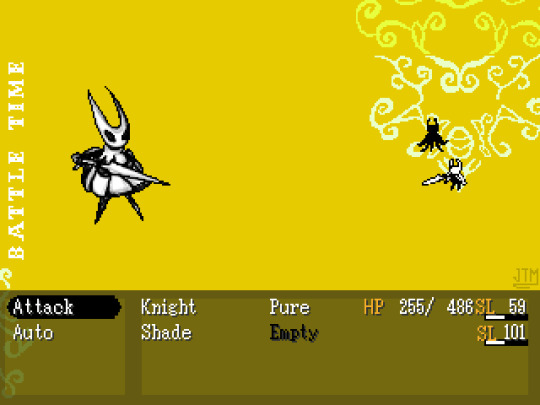


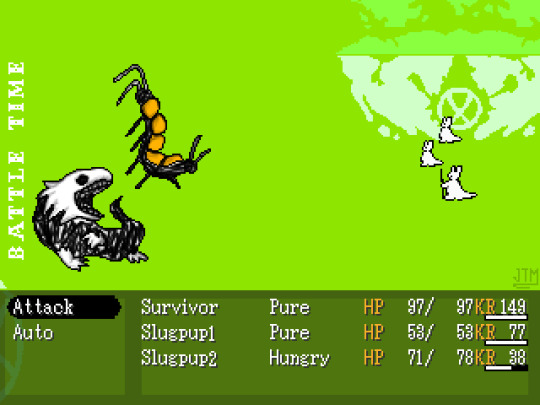
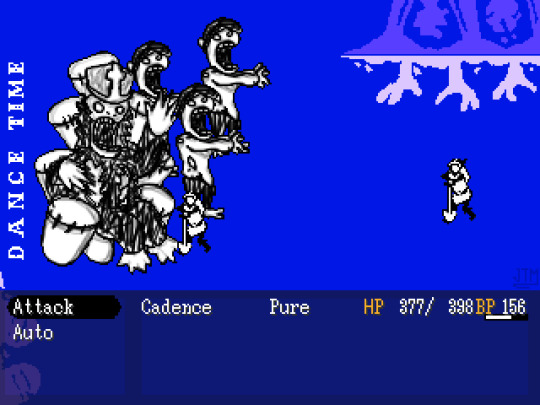
Indie Games in order:
Undertale Yume Nikki Oneshot Night In The Woods Celeste Hollow Knight Omori Cave Story Rainworld Crypt Of The Necrodancer
968 notes
·
View notes
Text
me messaging a casual acquaintance: hello, how are you?
me messaging a best friend w/zero lead-in:
72K notes
·
View notes
Text
New Design for a New Me Possibly!!

5 notes
·
View notes
Text

ehehehehe isaters but . smeefmeef art style
#I LOVE WHEN MY FAVORITE PIECES OF WORK MERGES INTO A DELICIOUS MEAL#COLORS#I love them#isat#smile for me
1K notes
·
View notes





